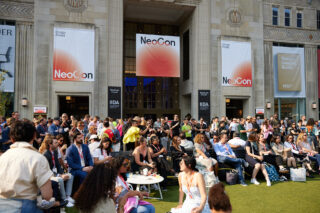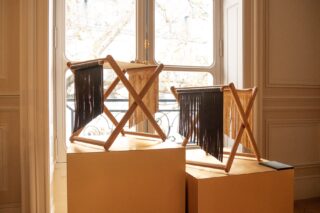Artists explored the tension between experimental and attention-driven art at Art Basel, highlighting divergent views on human creativity, AI’s role in art, and the future of post-articulation practices.
Each year Art Basel convenes in Miami Beach, bringing attendant satellite fairs scattered across the city, aggregating the best work from galleries around the world representing thousands of artists. These fairs and the galleries in them all come to Miami seeking the same end: recognition—they want to be seen by the press, collectors, and those collector’s assistants.
In short, Basel, as the titular fair of the weekend, is predicated on an attention economy.
Yet there is a countervailing impulse in art to eschew that very goal, instead opting to confound and transform itself in new directions. Attention is not antithetical to experimentation, but a trained gaze can shrink from what is new in favor of convention and the already recognizable.
“Experimental” contemporary art is not an exact categorization—there is no neat convention of art to rebel against; for many, avant-garde is dead. Individual experiments, though, still seem to exist in flashes. Harmony Korine, the director of films such as Gummo, Spring Breakers, and Trash Humpers, champions these experiments that challenge the trained, rote gaze of expectations.
A talk for Art Basel Miami conversations with Korine, painter Jill Mulleady, and artist Paul McCarthy, moderated by the critic and curator Hans Ulrich, captured the underlying tension of an art world that both disdains and subsists on attention and scalability.


Post-film, Post-Articulation, and Art
Korine, unlit cigar in mouth throughout the talk, discussed the lack of experimentation in film and other forms of art. He expressed that the constraints associated with mainstream commercial films—specifically the standard run-time of two hours and narrative arc of beginning-middle-end—reduced art to a formulaic set of conventions. At one point, Korine stated:
“I don’t care about [film] anymore.”
With his newest work, such as last year’s fully infrared, narratively meandering AI-informed art film, Aggro Dr1ft, Korine is exploring post-film: Audio-visual pieces that defy commercial film expectations in radical ways.
In explaining how this exceeds the concept of film, Korine explained that his newest work intended to go “beyond simple explanation”—calling this new approach “post-articulation,” more intent on complete aesthetic and experiential immersion rather than transmitting an idea. Post-articulation is art without a medium; post-articulation knows no delineation between one art form and the next.

Korine’s post-articulation relies on a certain incoherence, where the aesthetic outpaces the conceptual or where the constricting force of comprehensibility does not domesticate the feeling.
This same instinct was on display in the rows of Basel—such as James Rosenquist’s large, visually arresting pop-art painting “Women’s Intuition.”
he piece features swirling colors, predominantly pink, white, and red, morphing into one another, culminating in a kaleidoscopic configuration of colors on the verge of formlessness on the far-right side of the canvas. Yet, on the opposing side, some figurations point to its meaning: Two lipsticks are delineated, with all the noise of the other side emerging through them.
Rosenquist’s painting embodies Korine’s idea of post-articulation: It is not that the painting is conceptually empty, but rather that the image does not capitulate to the confines of a clear-cut message. The piece goes “beyond simple explanation” in its exploration of a capacious concept such as women’s intuition.
Searching for a Limit: AI and Painting
Post-articulation, for Korine, is tethered to emergent technologies, particularly the extra-human tool of AI.
In the Basel fair, one piece that incorporated AI stood out: “Mons. Steichen II,” by photographer Lisa Oppenheimer. While there may have been other pieces in the fair that utilized AI, this one related to Korine’s practice in a formal sense: It was a yellow color-saturated image, recalling the temperature-based infrared of Aggro Dr1ft. Oppenheimer used AI to generate the image of a hybrid flower, named after the photographer Edward Steichen, that no longer exists.
The piece was—in terms of experimental or conceptual flair—severely underwhelming. The concept of using AI to reproduce a flower that no longer existed was vaguely compelling, but image-design software already existed before AI that could produce such an image. Saturating the image in a bath of yellow did little in terms of rendering the image more visually dynamic.
“Mons. Steichen II” seemed to depend on its status as “AI art” more than its merits as an image.
AI was the most contentious subject of the talk: Korine claimed that it was “endless,” unlike paintings, asserting that they are bound to a limit by the canvas and paintbrush. However, another prominent artist on the panel, Jill Mulleady, seemed to find this reductive and untrue. She did concede that paintings are formally limited, but she remarked that they are “free” in another sense.
“You don’t need anything else [when painting],” said Mulleady, “. . . it isn’t connected to an AI engine.” She mentioned that she had experimented with AI but that there had been “no result.”
To Mulleady, despite painting being formally bound by the canvas, it is conceptually radically open. She defended painting as a distinctly human action unlike any other.

“When Do Robots Rebel” by Jamie Muñoz, shown by the Jeffry Deitch gallery booth, pertains directly to this discussion on AI and painting: Despite not using AI, it demonstrates how art can reflect on its limits and the place of technology. The piece features the terminator, with superimposed geometric lines and falling leaves framed by an outline of doves. Muñoz’s centering of a figure (the terminator) that embodies the underlying antagonism of AI—its potential to depose the human—has undeniable implications in the art world.
“When Do Robots Rebel” visually displays that the primacy of the human is now contested. Simultaneously, the painting, through its use of disparate iconography (doves, the terminator, and leaves) recalls the conceptual openness of human production.
Korine and Mulleady represent two distinct positions on the future of art. Either one can, like Mulleady, assert the distinctiveness of human artistic production and continue to explore the endless creativity of human consciousness. Or, like Korine, one can ride the anarchic wave of AI and get a glimpse of the post-human.
Both may be worthy, though very different, forms of artistic experimentation.











